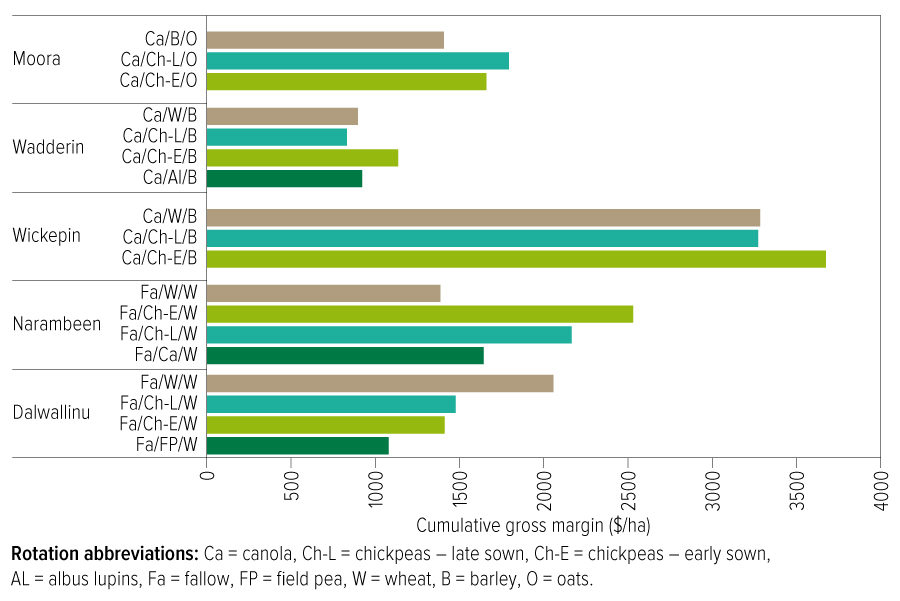Key points
- Double break crop sequences may yield higher profits than current canola-cereal sequences
- Early sowing, particularly in mid-April, can improve chickpea profitability
- Weed populations increased in the chickpea phase but did not adversely affect the subsequent cereal crop
Break crops play a vital role in managing biological constraints that hinder cereal production, however, their gross margin is often lower than that of cereal crops, which has limited their adoption. A double break may be the answer.
Break crops have traditionally been used singly to manage issues like high weed populations and soil pathogens but returns for growers have often fallen short of expectations.
With disease shifts and herbicide resistant weeds on the rise, the use of two break crops in sequence is emerging as a potentially more effective and more profitable strategy.
This approach is especially valuable when the biological constraints significantly impact crop sequence profitability compared to the lower profitability of break crops alone.
Under the leadership of Dr Nathan Craig from West Midlands Group together with Liebe Group, Facey Group and Corrigin Farm Improvement Group, a National Grower Network GRDC project has been exploring the potential of double-break crops in the medium (MRZ) and low-rainfall zone (LRZ) in Western Australia’s central wheatbelt.
Dr Craig says the ideal break crop traits include effective weed and pathogen control, coupled with high profitability. However, current options like canola and lupin, while effective, are rated moderate to low in profitability. Pasture phases, on the other hand, often result in a negative Gross Margin.
“This three-year study investigated the profitability of growing canola – with effective weed control options – followed by a high value legume – with higher economic value – as an effective and profitable double break crop sequence.
“The contribution of an early sowing date versus a traditional sowing date to further increase the profitability of the high value legume was also evaluated.”
Dr Craig says that capitalising on early sowing opportunities is vital to pulse adoption by ensuring maximum production and to not intrude on the optimal cereal sowing time in the region.
He says the stacking of two break-crops consecutively can also greatly improve weed and disease control in the following cereal crop.
Early sowing improves the probability of success, and was shown to be either similar or better for grain yield and economic return than late sowing.
Dr Craig likens early sowing to an insurance policy for growing high value legumes profitably in this region.
Six demonstration sites, without replications, were established across the MRZ and LRZ during the three years of the project from 2020-2022.
An existing paddock of canola or fallow (depending on rainfall zone) was selected to grow a high value legume which was followed by a cereal crop on a wide range of soil types.
Crop growth was monitored along with grain yield, and the Gross Margin was calculated to give an overall return on the three-year crop sequence.
Rainfall at most sites had a combination of below and above average seasonal rainfall that impacted on the growth and grain yield of either the double-break crop or the following cereal crop, but not both.
The results showed that incorporating canola or fallow, followed by an early-sown high-value legume – such as chickpea or lentil – was a profitable sequence that increased the Gross Margin of the three-year crop sequence which included the following cereal crop (Figure 1).
Figure 1. Cumulative Gross Margin over three years for each double-break crop rotation at each site compared to current practice (black bars). Sites presented contained three years of data to include the first and second break crop, followed by cereal.

Source: WMG
“Chickpeas, in particular, performed consistently across most sites and soil types- including deep sands, sandy loams and clay soils,” says Dr Craig.
“This suggests that the area suitable for chickpea production may have expanded due to successful soil amelioration undertaken across the wheatbelt in recent years.”
More information: Dr Nathan Craig, 0438 924 208, ceo@wmgroup.org.au
Find out more at On Farm Trials

























































